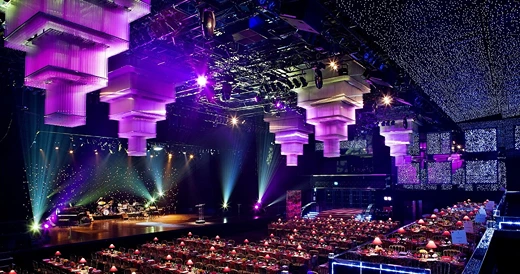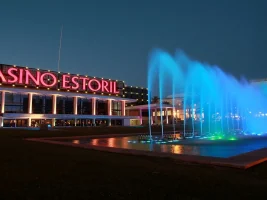Perched along the sun-drenched Portuguese Riviera in the charming town of Estoril, the Casino Estoril stands as a testament to Portugal’s knack for blending leisure with luxury. Just 18 kilometers southwest of Lisbon, this sprawling complex is more than a gambling hub—it’s a cornerstone of the region’s identity, radiating sophistication and a storied past. Established in the early 20th century, it has grown into one of Europe’s largest and most celebrated casinos, drawing visitors with its mix of high-stakes gaming, modernist architecture, and a vibrant cultural scene. For those exploring Western and Southern Europe’s most prestigious land-based casinos, Estoril offers an experience that feels both timeless and dynamic, rooted in its coastal setting and cosmopolitan allure.
The casino’s rise mirrors Estoril’s transformation from a quiet seaside village into a playground for the rich and famous. Its strategic location on Cascais Bay, framed by sandy beaches and palm-lined avenues, enhances its appeal, making it a natural stop for travelers along the Lisbon coast. Beyond the gaming tables, it serves up a feast for the senses—think fine dining with ocean views, live performances in grand halls, and gardens that invite a leisurely stroll. This article dives into:
- The casino’s fascinating history.
- Its striking architectural evolution.
- The multifaceted entertainment that keeps it a jewel in Portugal’s crown.
It’s a place where the thrill of a bet meets the elegance of a bygone era, all wrapped in a distinctly Southern European flair.
What sets Casino Estoril apart is its ability to fuse tradition with modernity, offering something for everyone—whether you’re a seasoned gambler, a culture enthusiast, or simply a curious visitor soaking in the Portuguese Riviera’s charm. Its legacy stretches back over a century, tied to tales of wartime intrigue and the glitz of mid-20th-century Europe, yet it remains a lively hub in 2025, adapting to contemporary tastes while honoring its roots. From its role in shaping Estoril’s identity to its status as a must-see landmark, this casino encapsulates the spirit of Western and Southern European sophistication, making it a standout treasure in the region’s casino landscape.
A Journey Through Time: The Evolution of Casino Estoril
The origins of Casino Estoril trace back to 1916, when Portugal’s then-president laid the foundation stone for what would become a bold venture in a nation eager to boost its coastal appeal. Conceived by entrepreneur Fausto Figueiredo, the casino was born out of a vision to rival the glamorous resorts of Monaco and France’s Côte d’Azur. At the time, Estoril was a sleepy fishing village with little to offer beyond its scenic shores, but Figueiredo saw potential in its proximity to Lisbon and its mild climate. The early casino was modest, a far cry from today’s sprawling complex, yet it quickly gained traction as a retreat for Portugal’s elite, laying the groundwork for its future prominence.

The 1930s and 1940s marked a turning point, thrusting Casino Estoril into the international spotlight. Portugal’s neutrality during World War II made it a haven for exiles, spies, and adventurers, and the casino became a nexus of intrigue and opulence. Wealthy refugees and diplomats flocked to its tables, their presence infusing the venue with a cosmopolitan energy that elevated its reputation. This era of clandestine meetings and high society cemented its mystique, drawing comparisons to the fictional casinos of spy novels. Key developments from this period include:
- Increased international visitors boosting its fame.
- Expansion of gaming options to cater to diverse tastes.
- Emergence as a cultural hub with live performances.
The wartime buzz faded with peace, but the casino’s allure endured, bolstered by its growing status as a cultural and gaming destination.
Expansion in the 1960s reshaped Casino Estoril into the powerhouse it is today. Under new ownership, the original structure was enlarged, adding gaming rooms, entertainment venues, and dining spaces to meet the demands of a burgeoning tourist trade. Ownership passed to a prominent Macau-based magnate in the 1980s, bringing fresh investment and a focus on modernizing facilities while preserving its classic charm. By 2025, it stands as a symbol of resilience, having weathered wars, economic shifts, and changing tastes. Its evolution reflects Portugal’s own journey toward global recognition, with notable shifts like:
- Transition from a local retreat to a European giant.
- Integration of modern technology in gaming and entertainment.
- Continued investment to maintain its competitive edge.
The casino’s historical milestones highlight its adaptability:
- 1916: Construction begins, marking Estoril’s tourism rise.
- 1931: Official opening as a full-fledged casino.
- 1940s: Becomes a wartime hotspot for international visitors.
- 1960s: Major expansion into a multi-purpose complex.
- 1987: New ownership modernizes operations.
These moments showcase how Casino Estoril grew into a Southern European icon.
Modernist Marvel: The Design and Ambiance of Casino Estoril
Casino Estoril’s architecture is a striking blend of modernist flair and coastal elegance, reflecting its role as a beacon of the Portuguese Riviera. Situated at the edge of Estoril Park, the building’s sleek lines and minimalist façade contrast with the lush gardens and palm trees that frame its entrance. Designed to harmonize with its seaside setting, the structure avoids the ornate excess of older European casinos, opting instead for a clean, functional aesthetic that feels both timeless and forward-looking. The exterior, bathed in soft lighting at night, exudes a quiet grandeur that beckons visitors up the gentle rise from Tamariz Beach.
Step inside, and the casino unfolds into a series of distinct spaces, each tailored to a different mood. Here’s a snapshot of its core gaming offerings:
| Game Type | Location | Features | Minimum Bet (Approx.) |
|---|---|---|---|
| Roulette | Main Gaming Floor | Classic European wheels | €5 |
| Blackjack | Main Gaming Floor | Multiple tables, side bets | €5 |
| Banca Francesa | Table Game Area | Unique Portuguese dice game | €5 |
| Poker | Dedicated Poker Room | Cash games and tournaments | €2-€5 (cash games) |
| Slot Machines | Slot Machine Rooms | 1,000+ machines, varied themes | €0.01 |
The main gaming floor hums with energy—slot machines line the walls, their high-definition screens flashing, while table games occupy the center, surrounded by players in smart attire. The Salão Preto e Prata, a cavernous hall with a capacity for 1,000, doubles as a dining and performance venue, its sleek design accented by bold black-and-silver decor. Smaller lounges, like the Zeno Lounge with its garden views, offer a more intimate feel, their modern furnishings softened by warm tones and natural light.
The casino’s design extends beyond its walls, with outdoor spaces enhancing its allure. The gardens, dotted with fountains that dance with color after dark, provide a serene escape, their pathways linking the casino to the nearby beachfront promenade. Renovations over the decades have kept the facilities cutting-edge—think advanced sound systems and climate control—while retaining a nod to its mid-century roots. Highlights of its ambiance include:
- Neon and crystal lighting creating a vibrant gaming atmosphere.
- Seamless flow from gaming to dining and performance spaces.
- Coastal-inspired decor tying it to the Riviera setting.
This balance of innovation and tradition makes Casino Estoril a standout in Western Europe, a place where the ambiance is as much a draw as the games.
Entertainment Beyond the Tables: A Hub of Leisure and Culture
Casino Estoril’s appeal stretches far beyond gambling, offering a rich tapestry of entertainment that cements its status as a Western and Southern European treasure. Open daily from 3 p.m. to 3 a.m., it buzzes with activity, its 1,000+ slot machines and 35+ table games—roulette, blackjack, baccarat, and the Portuguese dice game Banca Francesa—forming the heartbeat of its gaming offerings. The poker room, a magnet for enthusiasts, hosts cash games and tournaments, with stakes ranging from modest €5 bets to high-roller showdowns. Yet it’s the diversity of experiences beyond the tables that truly sets it apart, blending gaming with a full-spectrum leisure complex.
Dining is a cornerstone of the Casino Estoril experience, with options that showcase Portugal’s culinary flair and beyond. The Estoril Mandarim restaurant serves Cantonese cuisine in an elegant setting, its menu featuring over 100 dishes crafted with imported ingredients, a nod to its reputation as one of Europe’s finest Chinese eateries. The Zeno Lounge fuses Portuguese, Italian, and Brazilian flavors, its relaxed vibe and garden views making it a favorite for casual meals. The Buffet IN, housed in the slot machine area, offers a monthly rotating menu—think Portuguese seafood one month, Mediterranean spreads the next—all for a modest €15, drawing crowds with its value and variety.
The entertainment lineup is equally impressive, with venues like the Salão Preto e Prata hosting lavish shows—musicals, dance performances, and international acts—that rival Lisbon’s top theaters. The auditorium, seating 350, stages smaller concerts, from jazz to classical, and doubles as a conference space, its state-of-the-art tech ensuring a polished experience. The art gallery displays paintings and sculptures by emerging artists, its exhibitions free to the public. Lounges like Du Art offer live music nightly, from local bands to DJ sets, keeping the atmosphere lively without an entry fee. Additional leisure highlights include:
- Free parking and easy train access from Lisbon (36 minutes).
- Proximity to Tamariz Beach for a seaside day out.
- Garden terraces with evening light displays for a romantic touch.
This mix of culture and fun makes Casino Estoril a destination for all, not just gamblers, reinforcing its status as a vibrant hub on the Portuguese Riviera.

